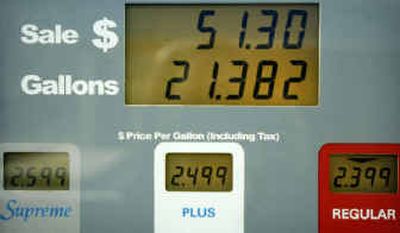Gas prices set record

As Erin Pepperman fed her Ford Explorer at a Spokane Valley gas station, with the total on the pump passing $40, a sign behind her told of a new reality: Gas prices are setting records.
The average price in Washington for regular unleaded reached $2.319 per gallon on Wednesday, a penny higher than the record set last May, according to the AAA office in Spokane.
Spokane’s average at $2.245 also surpassed former highs, as did Idaho’s average at $2.178, and Coeur d’Alene’s at $2.255.
The trend was reflected across the nation: for the first time, the average price for a gallon of gas is more than $2 in every state and the District of Columbia. Economists say that prices would have to rise to about $3 a gallon to top the inflation-adjusted costs of the early 1980s.
Still, a record is a record.
Pepperman can remember when people balked at paying more than $1 a gallon. Now, Pepperman said she avoids paying attention to the cost of gas “because it ticks me off.”
She groups her errands so she doesn’t have to make the trip from Fairchild Air Force Base more than once a week.
“On one budget, it’s hard,” said Pepperman, a stay-at-home mother of two.
A national expert on the issue said oil companies are able to raise the price because only about 2 percent to 3 percent of the public will reduce their driving as a result. Profits gained through price increases more than make up for any sales lost to conservation, said Tim Hamilton, executive director of the nonprofit Automotive United Trades Organization, based near Olympia.
“It’s going to continue to go up until the public lets go of the nozzle,” Hamilton said.
But annual surveys by AAA show that people generally find other ways to save money, like eating out less, rather than change their driving habits, said Dave Overstreet, a spokesman for the AAA in Spokane. The exact figure at which they’ll stop pumping gas differs by economic standing.
Figures from the Oil Price Information Service support that thesis. Despite climbing gas prices the past few months, consumption continues to rise.
Pam Grinnell saw the writing on the wall and traded in her beloved Ford Bronco for a Pontiac Sunfire a month ago. The Bronco was costing her $50 a week, at 10 miles per gallon, but her current ride fills up at $40 and gets three times that mileage.
“I had to get rid of it,” she said, after gassing up in the Valley.
AAA’s Overstreet encourages people taking such steps as getting a more fuel-efficient car, carpooling or using public transportation.
“It’s easy to say, ‘Let’s just regulate the industry,’ ” Overstreet said, “but if people are willing to make changes to reduce the amount of gas they consume, then that will drive down the price because a lot of the price of gasoline is supply and demand.”
Overstreet attributes the current rise in gasoline costs to increasing consumption, uncertainty in the Middle East and high price of crude oil. He doesn’t support government regulation of gas prices and believes the market will respond if people decrease their usage.
AUTO’s Hamilton disagrees. Three quarters of the oil supplying the Northwest comes from Alaska, Hamilton said, and yet this region pays 30 cents more for gas than the Southeast, which gets its oil from the Organization of the Petroleum Exporting Countries.
The issue at hand, Hamilton said, is that oil companies can charge as much as they want.
“There is no end to their desire for profits,” Hamilton said. “We wouldn’t have to be paying this high price if the government got off its rump and stopped the oil companies behaving this way.”